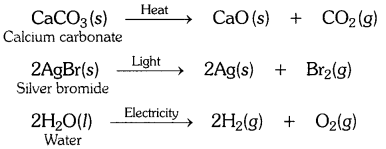NCERT Solutions for Class 10 Science Updated for 2022-23
The first Chapter of Class 10 Science is Chemical Reactions and Equations, as name suggest this chapter 1 is all about chemical reaction and its equation, how to write equations, how to conduct combination, different types of reactions decomposition reactions, and more. Students who are preparing for their Class 10 exams and searching for chapter-wise NCERT Solution for Class 10 Science must go through NCERT Solutions for Class 10 Science Chapter 1 Chemical Reactions and Equations.
ALSO CHECK – NCERT Solutions for Class 10 Maths
These NCERT Solutions for Class 10 Science Chapter 1 are prepared by our best subject experts teachers group thats help students to understand all the topics easily. With the help of these NCERT Solutions for Science, students can understand the complex topics of class 10 science. We all know Science is a subject that needs a clear understanding of the concepts and topics to score well in it.
ALSO CHECK – 5 Best Laptop under 30000 in India 2022
NCERT Solutions for Class 10 Science Chapter 1 – Intext Exercise 1
Question 1
Why should a magnesium ribbon be cleaned before burning in air ?
Answer:
Magnesium gets covered with a layer of magnesium oxide when kept in air for a long time. This layer hinders the burning of magnesium. Hence, it is to be cleaned before burning.
Question 2
Write the balanced equation for the following chemical reactions.
(i) Hydrogen + Chlorine → Hydrogen chloride
(ii) Barium chloride + Aluminium sulphate → Barium sulphate + Aluminium chloride
(iii) Sodium + Water → Sodium hydroxide + Hydrogen
Answer:
(i) H2 + Cl2 → 2HCl
(ii) 3 BaCl2 + Al2(SO4)3 → BaSO4 + 2 AlCl3
(iii) 2Na + 2H2O → 2NaOH + H2↑
Question 3
Write a balanced chemical equation with state symbols for the following reactions :
(i) Solutions of barium chloride and sodium sulphate in water react to give insoluble barium sulphate and the solution of sodium chloride.
(ii) Sodium hydroxide solution (in water) reacts with hydrochloric acid solution (in water) to produce sodium chloride solution and water.
Answer:
(i) BaCl2 (aq) + Na2SO4 (aq) → BaSO4(s) + 2NaCl (aq)
(ii) NaOH (aq) + HCl(aq) → NaCl(aq) + H2O(l)
Intext Exercise 2
Question 1
A solution of a substance ‘X’ is used for white washing.
(i) Name the substance ‘X’ and write its formula.
(ii) Write the reaction of the substance ‘X’ named in (i) above with water.
Answer:
(i) The substance whose solution in water is used for white washing is calcium oxide (or quick lime). Its formula is CaO.

Question 2
Why is the amount of gas collected in one of the test tubes in text book Activity 1.7 (i.e., electrolysis of water) double of the amount collected in the other? Name this gas. [CBSE 2015 (Delhi)]
Answer:
In Activity 1.7, water is electrolysed to give H2 gas at one electrode and O2 gas at the other electrode.
2H2O(l) → 2H2(g) + O2(g)
Thus two molecules of water on electrolysis give two molecules of hydrogen gas and one molecule of oxygen gas or in other words the amount of hydrogen gas collected would be double than that of oxygen gas.
Intext Exercise 3
Question 1
Why does the colour of copper sulphate solution change when an iron nail is dipped in it ?
OR
An iron nail is dipped in the solution of copper sulphate for about 30 minutes. State the change in colour observed. Give reason for the change. [CBSE 2015 (Delhi)]
Answer:
When an iron nail is dipped in copper sulphate solution, the displacement reaction takes place. The colour of copper sulphate solution fades due to the formation of light green solution of iron sulphate.
![]()
Question 2
Give an example of a double displacement reaction other than the one given in Activity 1.10 (NCERT Text Book).
Answer:
Sodium hydroxide and hydrochloric acid react to form sodium chloride and water.
![]()
Question 3
Identify the substances that are oxidised and the substances which are reduced in the following reactions.
(i) 4Na(s) + O2(g) → 2Na2O(s)
(ii) CuO (s) + H2(g) → Cu (s) + H2O(l)
Answer:
(i) Substances oxidised is Na as it gains oxygen and oxygen is reduced.
(ii) Substances reduced is Cu as hydrogen is oxidised as it gains oxygen.
NCERT Solutions for Class 10 Science Chapter 1 Textbook Chapter End Questions
Question 1
Which of the statements about the reaction below are incorrect ?
2 PbO(s) + C(s) → 2Pb (s) + CO2(g)
(a) Lead is getting reduced.
(b) Carbon dioxide is getting oxidised.
(c) Carbon is getting oxidised.
(d) Lead oxide is getting reduced.
(i) (a) and (b)
(ii) (a) and (c)
(iii) (a), (b) and (c)
(iv) All
Answer:
(i) (a) and (b)
Question 2
Fe2O3 + 2Al → Al2O3 + 2Fe
The above reaction is an example of a
(a) combination reaction
(b) double displacement reaction
(c) decomposition reaction
(d) displacement reaction
Answer:
(d) Displacement reaction.
Question 3
What happens when dilute hydrochloric acid is added to iron filings ? Tick the correct answer :
(a) Hydrogen gas and iron chloride are produced.
(b) Chlorine gas and iron hydroxide are produced.
(c) No reaction takes place.
(d) Iron salt and water are produced.
Answer:
(a) Hydrogen gas and iron chloride are produced.
Question 4
What is a balanced chemical equation ? Why should chemical equations be balanced ?
Answer:
A balanced chemical equation consists of the equal number of moles of the elements in the reactants and that in the products.
Chemical equations should be balanced, as according to the law of conservation of mass, mass can neither be created nor can be destroyed. Therefore, in a chemical reaction, the total mass of reactant should be equal to the total mass of products. Hence, a balanced chemical equation has total mass of reactants equal to total mass of products.
Question 5
Translate the following statements into chemical equations and then balance them.
(a) Hydrogen gas combines with nitrogen to form ammonia.
(b) Hydrogen sulphide gas burns in air to give water and sulphur dioxide.
(c) Barium chloride reacts with aluminium sulphate to give aluminium chloride and a precipitate of barium sulphate.
(d) Potassium metal reacts with water to give potassium hydroxide and hydrogen gas.
Answer:
(a) 3H2 (g) + N2 (g) → 2NH3 (g)
(b) H2S (g) + 3O2 (g) → SO2 (g) + 2H2O(l)
(c) 3BaCl2 (aq) + Al2(SO4)3 (aq) → 2AlCl3 (aq) + 3BaSO4 ↓(s)
(d) 2K (s) + 2H2O (l) → 2KOH (aq) + H2 (g)
Question 6
Balance the following chemical equations :
(a) HNO3 + Ca (OH)2 → Ca (NO3)2 + H2O
(b) NaOH + H2SO4 → Na2SO4 + H2O
(c) NaCl + AgNO3 → AgCl + NaNO3
(d) BaCl2 + H2SO4 → BaSO4 + HCl
Answer:
(a) 2HNO3 + Ca(OH)2 → Ca(NO3)2 + 2H2O
(b) 2NaOH + H2SO4 → Na2SO4 + 2H2O
(c) NaCl + AgNO3 → AgCl + NaNO3
(d) BaCl2 + H2SO4 → BaSO4 + 2HCl
Question 7
Write the balanced chemical equations for the following reactions :
(a) Calcium hydroxide + Carbon dioxide → Calcium carbonate + Water
(b) Zinc + Silver nitrate → Zinc nitrate + Silver
(c) Aluminium + Copper chloride → Aluminium chloride + Copper
(d) Barium chloride + Potassium sulphate → Barium sulphate + Potassium chloride
Answer:
(a) Ca (OH)2 + CO2 → CaCO3 + H2O
(b) Zn + 2AgNO3 → Zn(NO3)2 + 2 Ag
(c) 2Al + 3 CuCl2 → 2AlCl3 + 3 Cu
(d) BaCl2 + K2SO4 → BaSO4 + 2KCl
Question 8
Write the balanced chemical equation for the following and identify the type of reaction in each case :
(a) Potassium bromide (aq) + Barium iodide (aq) → Potassium iodide (aq) + Barium
(b) Zinc carbonate(s) → Zinc oxide (s) + Carbon dioxide (g) bromide(s)
(c) Hydrogen (g) + Chloride (g) → Hydrogen chloride (g)
(d) Magnesium (s) + Hydrochloric acid (aq) → Magnesium chloride (aq) + Hydrogen (g)
Answer:
(a) 2KBr (aq) + Bal2(aq) → 2Kl(aq) + BaBr2(s)
Type : Double displacement reaction
(b) ZnCO3 (s) → ZnO (s) + CO2 (g)
Type : Decomposition reaction
(c) H2 (g) + Cl2 (g) → 2HCl(g)
Type : Combination reaction
(d) Mg (s) + 2HCl (aq) → MgCl2 (aq) + H2 (g)
Type : Displacement reaction
Question 9
What does one mean by exothermic and endothermic reactions ? Give examples.
Answer:
Exothermic reactions : Those reactions in which heat is evolved are known as exothermic reactions. An exothermic reaction is indicated by writing “+ Heat”on the products side of an equation.
Example :
(i) C (s) + O2 (g) → CO2 (g) + Heat
(ii) N2 (g) + 3H2 (g) → 2NH3 (g) + Heat
Endothermic reactions : Those reactions in which heat is absorbed are known as endothermic reactions. An endothermic reaction is usually indicated by writing “Heat” on the product side of a chemical equation.
Examples :
(i) C (s) + 2S (s) → CS2 (l) – Heat
(ii) N2 (g) + O2 (g) → 2NO(g) – Heat
Question 10
Why is respiration considered an exothermic reaction ? Explain.
Answer:
Respiration is an exothermic process because during respiration glucose combines with oxygen in the cells of our body to form carbon dioxide and water along with the production of energy.
![]()
Question 11
Why are decomposition reactions called the opposite of combination reactions? Write equations for these reactions.
Answer:
In a decomposition reaction, a single compound breaks down to produce two or more simpler substances.
For example:

While, in a combination reaction, two or more substances simply combine to form a new substance.
For example:
![]()
Question 12
Write one equation each for the decomposition reactions where energy is supplied in the form of heat, light or electricity.
OR
Decomposition reactions require energy either in the form of heat or light or electricity for breaking down the reactants. Write one equation each for decomposition reactions where energy is supplied in the form of heat, light and electricity. [CBSE 2015 (Delhi)]
Answer:

Question 13
What is the difference between displacement and double displacement reactions? Write equations for these reactions.
Answer:
In displacement reactions, a more reactive metal displaces a less reactive metal from its solution. For example,
Fe(s) + CuSO4(aq) → Cu(s) + FeSO4(aq)
This is a displacement reaction where iron displaces copper from its solution.
In double displacement reactions, two reactants in solution exchange their ions. For example,
AgNO3(aq) + NaCl (aq) → AgCl(s) + NaNO3 (aq)
This is a double displacement reaction where silver nitrate and sodium chloride exchange Cl– and NO3–ions between them.
Question 14
In the refining of silver, the recovery of silver from silver nitrate solution involved displacement by copper metal. Write down the reaction involved.
Answer:
![]()
Question 15
What do you mean by a precipitation reaction ? Explain by giving examples.
Answer:
A reaction in which an insoluble solid called precipitate is formed that separates from the solution is called a precipitation reaction.
Example : When a solution of iron (III) chloride and ammonium hydroxide are mixed, a brown precipitate of iron (III) hydroxide is formed.
![]()
Question 16
Explain the following in terms of gain or loss of oxygen with two examples each:
(a) Oxidation and
(b) Reduction.
Answer:
(a) Oxidation : The addition of oxygen to a substance is called oxidation.
Example :
(i) S(s) + O2(g) → SO2(g) (Addition of oxygen to sulphur)
(ii) 2Mg(s) + O2 (g) → 2MgO(s) (Addition of oxygen to magnesium)
(b) Reduction : The removal of oxygen from a substance is called reduction.
Example: (i) CuO + H2 𝐻𝑒𝑎𝑡−→−− Cu + H2O
Here, copper oxide is being reduced to copper because oxygen gets removed from copper oxide.
(ii) ZnO + C → Zn + CO
Here, zinc oxide is being reduced to zinc because oxygen gets removed from zinc oxide.
Question 17
A shiny brown coloured element ‘X’ on heating in air becomes black in colour. Name the element ‘X’ and the black coloured compound formed.
Answer:
Element ‘X’ is copper (Cu).
The black coloured compound is copper oxide (CuO). The reaction involved is
![]()
Question 18
Why do we apply paint on iron articles ?
Answer:
Iron is a reactive metal and can react with moisture and air. Iron articles, if exposed for a long time in moisture or air, can get corroded and form rust. So, paint is applied on iron articles to prevent rusting and form a protective layer for exposure to air and moisture.
Question 19
Oil and fat containing food items are flushed with nitrogen. Why ?
Answer:
Oils and fat containing items are perishable and can be spoiled when exposed to oxygen. This is because oil and fats are reactive and can react with oxygen easily and get oxidised. To prevent oxidation, these items are flushed with nitrogen gas. Nitrogen is an inert gas and cannot react with oils or fats easily. So, food items with oils and fats are kept in packets having nitrogen gas that increases the shelf life and makes these items last for a long time.
Question 20
Explain the following terms with one example each (a) Corrosion, (b) Rancidity.
Answer:
(a) Corrosion : Corrosion is defined as a process where a substance, generally metal deteriorates and forms a layer of oxide on its surface. Metals get converted into their hydrated oxides or sulphides.
Example : When iron is exposed to moist air for a long period of time, its surface acquires a coating of a brown, flaky substance called rust. Rust is mainly hydrated iron (III) oxide [Fe2O3.xH20].

(b) Rancidity : It is a process in which food items like fats and oils are oxidised. This results in the change in taste and smell of the food item and is called rancidity. For example, when any fried food is exposed to air for a long time then it has a change in smell and taste and it becomes rancid.
Rancidity can be avoided by:
Adding antioxidants like BHA (Butylated tri hydroxy anisole)
Refrigerate the food items
keep food items in airtight containers
Adding nitrogen to food packets to prevent oxidation.







